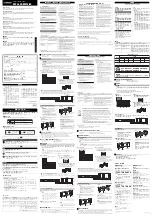
Reset and clock control for STM32F42xxx and STM32F43xxx (RCC)
RM0090
150/1731
DocID018909 Rev 11
6
Reset and clock control for
STM32F42xxx and STM32F43xxx (RCC)
6.1 Reset
There are three types of reset, defined as system Reset, power Reset and backup domain
Reset.
6.1.1 System
reset
A system reset sets all registers to their reset values except the reset flags in the clock
controller CSR register and the registers in the Backup domain (see
).
A system reset is generated when one of the following events occurs:
1.
A low level on the NRST pin (external reset)
2. Window watchdog end of count condition (WWDG reset)
3. Independent watchdog end of count condition (IWDG reset)
4. A software reset (SW reset) (see
5. Low-power management reset (see
)
Software reset
The reset source can be identified by checking the reset flags in the
.
The SYSRESETREQ bit in Cortex
®
-M4 with FPU Application Interrupt and Reset Control
Register must be set to force a software reset on the device. Refer to the Cortex
®
-M4 with
FPU technical reference manual for more details.
Low-power management reset
There are two ways of generating a low-power management reset:
1.
Reset generated when entering the Standby mode:
This type of reset is enabled by resetting the nRST_STDBY bit in the user option bytes.
In this case, whenever a Standby mode entry sequence is successfully executed, the
device is reset instead of entering the Standby mode.
2. Reset when entering the Stop mode:
This type of reset is enabled by resetting the nRST_STOP bit in the user option bytes.
In this case, whenever a Stop mode entry sequence is successfully executed, the
device is reset instead of entering the Stop mode.
6.1.2 Power
reset
A power reset is generated when one of the following events occurs:
1.
Power-on/power-down reset (POR/PDR reset) or brownout (BOR) reset
2. When exiting the Standby mode
A power reset sets all registers to their reset values except the Backup domain (see
















































